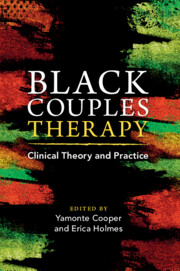Book contents
- Black Couples Therapy
- Black Couples Therapy
- Copyright page
- Contents
- Figures
- Tables
- Contributors
- Foreword
- Acknowledgments
- Introduction
- Part I Race, Racism, and Identity
- Part II Foundations for Healthy Coupling
- Part III Adapting Major Therapeutic Approaches for Work with African American Couples
- Part IV Sex and Intimacy
- Part V Special Topics
- Chapter 14 Weathering the Storm: Fertility and the Black Lesbian Experience
- Chapter 15 African American Men and Infertility: Biopsychosocial Considerations
- Chapter 16 Couples Therapy with Black American Couples Facing Medical Illness: Considerations for Treatment
- Index
- References
Chapter 16 - Couples Therapy with Black American Couples Facing Medical Illness: Considerations for Treatment
from Part V - Special Topics
Published online by Cambridge University Press: 27 July 2023
- Black Couples Therapy
- Black Couples Therapy
- Copyright page
- Contents
- Figures
- Tables
- Contributors
- Foreword
- Acknowledgments
- Introduction
- Part I Race, Racism, and Identity
- Part II Foundations for Healthy Coupling
- Part III Adapting Major Therapeutic Approaches for Work with African American Couples
- Part IV Sex and Intimacy
- Part V Special Topics
- Chapter 14 Weathering the Storm: Fertility and the Black Lesbian Experience
- Chapter 15 African American Men and Infertility: Biopsychosocial Considerations
- Chapter 16 Couples Therapy with Black American Couples Facing Medical Illness: Considerations for Treatment
- Index
- References
Summary
African American couples facing medical illness have received limited attention within the couples psychotherapy literature. This chapter highlights research and theory relevant to couples coping with medical illness within sociohistorical and culturally relevant conceptual frameworks in clinical practice. Considerations for clinical practice are offered.
- Type
- Chapter
- Information
- Black Couples TherapyClinical Theory and Practice, pp. 348 - 362Publisher: Cambridge University PressPrint publication year: 2023



